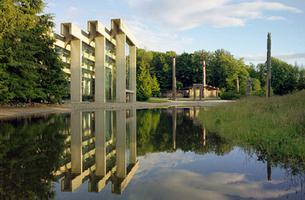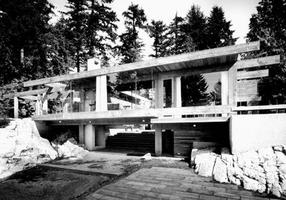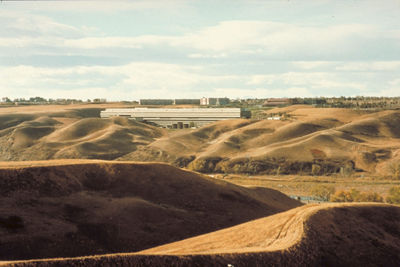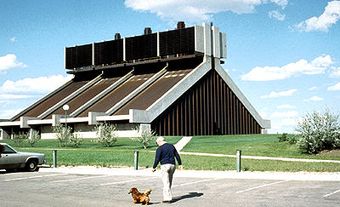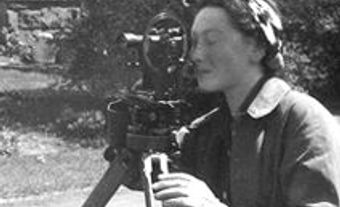Arthur Charles Erickson
Arthur Charles Erickson, architect (b at Vancouver, BC 14 June 1924, d at Vancouver 20 May 2009). Erickson studied at UBC and McGill and completed his architectural training in 1950. Army service took him to Asia, and after graduation he travelled in Europe and the Middle East. In partnership with Geoffrey Massey he began private practice in Vancouver in 1953; their success in the design competition for SFU in 1963 brought them international attention.
A series of major commissions followed, including theme buildings at Expo 67 in Montréal; the MacMillan Bloedel office tower in Vancouver in 1969; the Canadian Pavilion, Expo 70, Osaka, Japan; U of Lethbridge, 1971; the Museum of Anthropology at UBC, 1971-77; the provincial government offices and courthouse (and Vancouver Art Gallery) complex, begun in 1973; the Bank of Canada, Ottawa, 1980, in association with Marani, Rounthwaite & Dick; and Roy Thomson Hall, Toronto, 1982. (See also Toronto Feature: 60 Simcoe St.
Erickson also received numerous commissions from Middle Eastern countries, South America and the US, where he was architect for the Canadian embassy in Washington (opened May 1989). Among many awards and honours, Erickson received the Royal Bank Award (1971) and the Chicago Architectural Award (1984, with Philip Johnson and Joan Burgee); as well, he received gold medals from the Royal Architectural Institute of Canada (1984) and the American Institute of Architects (1986).
Perhaps the first Canadian architect to be widely known by the international public, he gained wide popular regard for his ability to create dramatic places with apparently simple means. A consistent theme through many of his buildings is the framing portal of horizontal beam on vertical columns, a welcoming and sheltering motif found in West Coast Native buildings, but which also looks back to the architecture of ancient Greece. Such restricted means, with muted colours, are used in his best buildings to create a sense of place and occasion. They also provide the means to create buildings integral to the landscapes in which they are placed.
Some work of the 1980s demonstrates an explicit response to historic forms and precedents. The restraint and sensitivity which informed the design of the Puget Sound House (1983-86) is an example of such a response, as is the Canadian Chancery, Washington (1983-88) where the city's neo-classical traditions suggested important themes. His unsuccessful entry in the 1988 Chicago Library competition fell away from this high standard, perhaps reflecting an uncertain mood during the peak of "post-modern" attacks on the modernism of which Erickson has been such a distinguished exponent.
Erickson's international design success rested on his ability to attract and lead talented associates in widely separated offices (Vancouver, Toronto, Los Angeles, Abu Dhabi). Management of his business affairs was not as successful. Financial problems in the late 1980s led to the closing of his offices (in 1989 and 1991). He continued to live and work in Vancouver, practising in association with established Vancouver firms.
He was named a companion of the Order of Canada in 1981.

 Share on Facebook
Share on Facebook Share on X
Share on X Share by Email
Share by Email Share on Google Classroom
Share on Google Classroom
